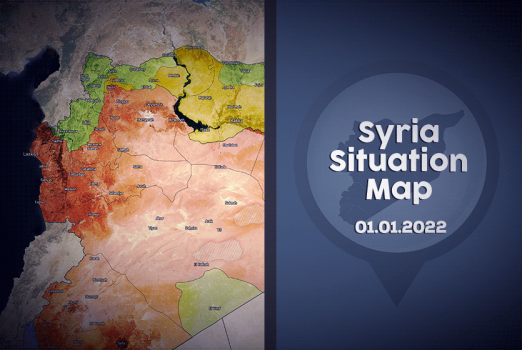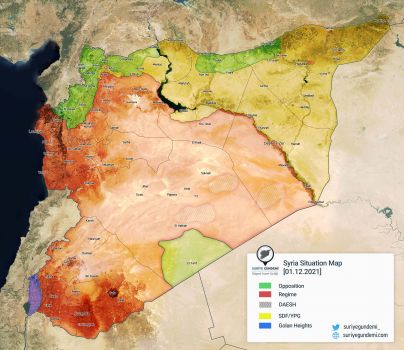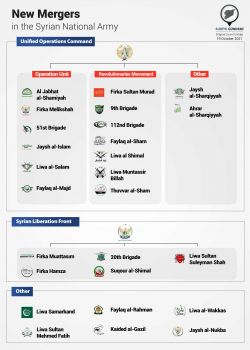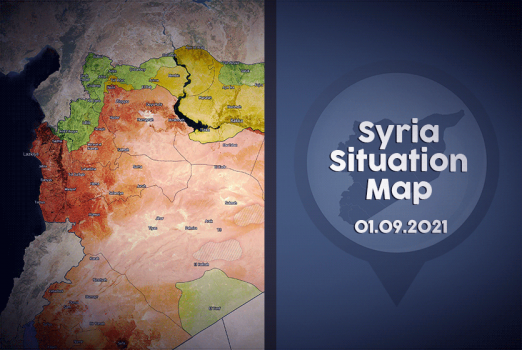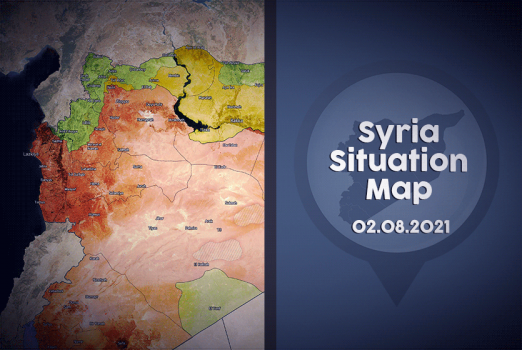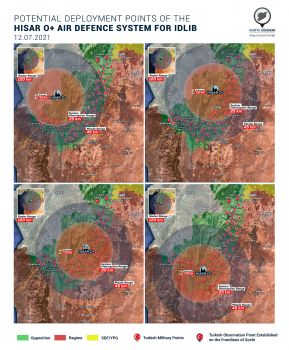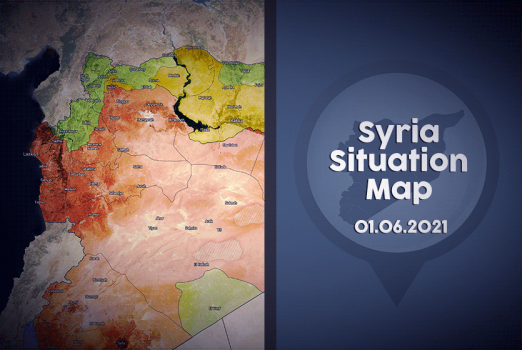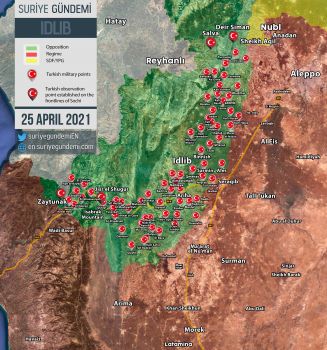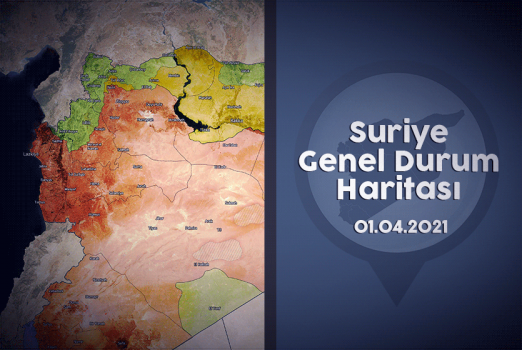In the holistic view, the Syrian economy is suffering from conflict-related hyperinflation for years now. The World Bank estimated that Syria’s overall GDP loss from 2011 to 2016 is at $ 230 billion, while the reconstruction cost is at $390 billion.[1] From the beginning of this year, the economic situation in the regime-held territories has significantly worsened. One year from now one American dollar equaled 600 Syrian pounds. With the inflation rate having spurred further these days, one US dollar has been traded for 1940 Syrian pounds, while the official rate announced by the Central Bank holds at 514 SYP for a dollar.[2] Two major reasons contributed to a further devaluation of a Syrian pound and a meltdown of Damascus’ economy: The first one being the collapse of a Lebanese banking sector and the second being a COVID-19 pandemic.
Regime’s economy hit by Lebanon’s Crisis
Syrian currency was relatively stable for over three years following the Russian intervention at the end of 2015, yet it has never recovered to its pre-civil war value of 50 pounds for a dollar.[3] With the U.S. and EU sanctions having been imposed on Damascus for its immense human rights violations back in 2011, the Assad regime’s access to hard currency had been largely constrained. Consequently, the dollarized economy of a neighboring Lebanon remained its sole stronghold. The Assad’s government, as well as ordinary Syrian citizens, have long-lasting ties with the Lebanese banking sector since the 1960s, when Syrian private capital fled to the country once Damascus nationalized its banks.[4] With a political turmoil in Syria starting in 2011, even more, capital outflow from Damascus to Beirut. To elaborate, in July 2011 The Economist reported that over $20 billion had been transferred from one country to another. Furthermore, The Financial Times stated that over 80 percent of wealthy Syrians kept their financial assets in Beirut. However, after over two decades of pegging its currency to the US dollar, Lebanon is mired in debt to a point it is no longer able to peg. Moreover, the pressure put on Beirut by the West, which is fully aware of Lebanon’s non-compliance with the sanctions imposed on Damascus, should not be overlooked.[5] As a result, Damascus is no longer able to use Lebanon to evade sanctions as it did before. This dynamic left the regime suffocating with nearly zero access to hard currency left. With such a development in Lebanon, Syrian imports became more expensive since the hard currency is needed to pay for them. This led to a fall of a Syrian pound. Despite the regime’s attempts to increase salaries and minimum wages to the citizens in regime-held areas, not much of a difference has been made to improve the lives of ordinary people.
Damascus’ Economy further suffocated by COVID-19
Another problem faced by the regime’s economy is the spread of coronavirus since mid-March when the first case of disease had been officially reported. Due to the regime’s Ministry of Health’s systematic cover-ups, only 58 cases are reported and the optimistic forecast is made regarding the crisis: as of today, 36 recoveries and only 3 deaths.[6] Despite such a rosy picture presented by Damascus regarding a spread of a global pandemic on its territories, a further economic meltdown provides a rather different reading of a situation. With the Syrian pound holding at 1000 pounds for a dollar on a black market in January 2020, it has already reached 1300 pounds for a dollar in March. It has also been reported that as a result of a spurred inflation in the last couple of months, the groceries varied in prices in 40-75 percent. Another implication of the coronavirus on the regime’s economy comes from abroad. Syria is largely dependent on the worker transmittals from some neighboring countries that are major sources of remittances to Syria, such as Saudi Arabia (29%), Lebanon (17%), Jordan (15%), and Turkey (14%).[7] Since the lockdowns to prevent the spread of virus were declared in almost all of these countries, a disruption inflow of remittances from Syrians living abroad occurred.
Already shattered by the Western sanctions and recent developments in Lebanon, Damascus’ economic condition had been further jeopardized by the social distancing measures as a result of the world pandemic. This makes some of the prominent pro-regime crony entrepreneurs lobby for a partial lifting of the restrictions. Yet, the regime’s health-care system’s devastating conditions will not be able to bear such potential risk. The regime’s Finance Minister, Mamoun Hamdan stated that Damascus will spend 100 billion pounds to fight the pandemic.[8] With the drop in the value of a national currency, such a statement only demonstrates regime’s desperation, since the amount mentioned equals approximately $75 million (i.e. only $5 to be spent on the health of an ordinary Syrian).[9] Such a comprehensive economic condition even led Damascus to call the US and EU for a suspension of sanctions on humanitarian grounds in the UN.[10] Paradoxically, the latter issued a report confirming the regime’s use of chemical weapons, as well as its bombing of civilians earlier this month.
Conclusion
Currently, the collapse of the Lebanese banking sector, the spread of a novel coronavirus as well as previously imposed Western sanctions are major factors leading the Bashar al-Assad regime’s already dried out the economy from bad to worse. Both, the crash of Lebanese financial sector and global pandemic resulted in Damascus’ further inaccessibility to hard currency, from which it suffers from the beginning of 2011 when sanctions were imposed on it by the West. The pandemic has negative imprints on its economy from the outside rather than from within with disruption of the flow of remittances it has brought. Thus the lockdowns in many countries have shattered already hardly breathing regime’s economy by further constraining its grip on hard currency.
[1] “Syria.” Syria Economy: Population, GDP, Inflation, Business, Trade, FDI, Corruption. Accessed May 18, 2020. https://www.heritage.org/index/country/syria
[2]“COVID-19 and the Economy in Regime-Held Syria.” FDD, April 29, 2020. https://www.fdd.org/analysis/2020/04/21/covid-19-and-economy-in-syria/
[3] Danny Makki. “Damascus Battles Economic Collapse as the Syrian Pound Plummets.” Middle East Institute, May 18, 2020. https://www.mei.edu/publications/damascus-battles-economic-collapse-syrian-pound-plummets
[4] “Syria’s Economy Goes from Very Bad to Worse as Lebanon’s Crisis Hits.” Middle East Eye, January 11, 2020. https://www.middleeasteye.net/news/bad-worse-syrias-financial-crisis-hit-lebanons-economic-free-fall
[5] Cochrane, Paul. “Syria’s Economy Goes from Very Bad to Worse as Lebanon’s Crisis Hits.” Middle East Eye, January 11, 2020. https://www.middleeasteye.net/news/bad-worse-syrias-financial-crisis-hit-lebanons-economic-free-fall
[6] “ Syria.” Worldometer. Accessed May 18, 2020. https://www.worldometers.info/coronavirus/country/syria/
[7] Christou, Will. “Economic Disaster Looms as Coronavirus Lockdowns Reduce Remittances to Syria.” Syria Direct, April 12, 2020. https://syriadirect.org/news/coronavirus-reduces-remittances-and-threatens-to-upend-syria’s-economy/
[8] Enab Baladi. “Syria’s Economy amidst Coronavirus Crisis…supporting Traders as Unemployment Increases and Prices Hike.” Enab Baladi, April 19, 2020. https://english.enabbaladi.net/archives/2020/04/syrias-economy-amidst-coronavirus-crisissupporting-traders-as-unemployment-increases-and-prices-hike/
[9] Adesnik, David. “COVID-19 and the Economy in Regime-Held Syria.” FDD, April 29, 2020. https://www.fdd.org/analysis/2020/04/21/covid-19-and-economy-in-syria/
[10] “Al-Jaafari: Syria Demands That Washington Immediately and Unconditionally Lift All Coercive Economic Measures Imposed on It.” Syrian Arab News Agency, April 1, 2020. https://sana.sy/en/?p=189198





